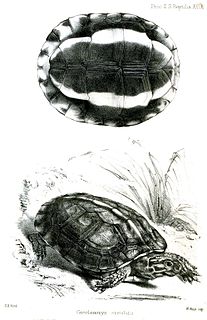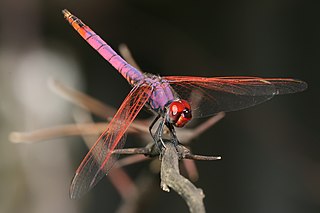
The banded cat-eyed snake is a species of medium-sized, mildly venomous, colubrid snake endemic to the New World.

Theileria is a genus of parasites that belongs to the phylum Apicomplexa and is closely related to Plasmodium. Two Theileria species, T. annulata and T. parva, are important cattle parasites. T. annulata causes tropical theileriosis and T. parva causes East Coast fever. Theileria are transmitted by ticks. The genomes of T. orientalis Shintoku, Theileria equi WA, Theileria annulata Ankara and Theileria parva Muguga have been sequenced and published.

The brown wood turtle or brown land turtle is a species of turtle in the family Geoemydidae. The species is endemic to Central America and northern South America.

Trithemis annulata, known commonly as the violet dropwing, violet-marked darter, purple-blushed darter or plum-coloured dropwing, is a species of dragonfly in the family Libellulidae. It is found in most of Africa, in the Middle East, in the Arabian Peninsula and southern Europe. These insects are called dropwings because of their habit of immediately lowering their wings after landing on a perch. Males of this species are violet-red with red veins in the wings while females are yellow and brown. Both sexes have red eyes.

Naja annulata, commonly known as the banded water cobra or the ringed water cobra, is a species of water cobra native to western and central Africa. The species is one of the two species of water cobras in the world, the other one being the Congo water cobra.

Nyctemera annulata, commonly known as the magpie moth, is a moth of the family Erebidae. It is endemic to New Zealand and found in all parts of the country.
This article lists the various snakes of Australia which live in a wide variety of habitats around the continent. The amethystine python or scrub python is considered Australia's largest native snake.
Nyctonympha is a genus of longhorn beetles of the subfamily Lamiinae, containing the following species:
Nyctonympha andersoni is a species of beetle in the family Cerambycidae. It was described by Martins and Galileo in 1992. It is known from Bolivia and Colombia.
Nyctonympha genieri is a species of beetle in the family Cerambycidae. It was described by Martins and Galileo in 1992. It is known from Ecuador.
Nyctonympha howdenarum is a species of beetle in the family Cerambycidae. It was described by Martins and Galileo in 1992. It is known from Colombia.
Nyctonympha taeniata is a species of beetle in the family Cerambycidae. It was described by Martins and Galileo in 1992. It is known from Panama and Trinidad and Tobago.
Nyctonympha affinis is a species of beetle in the family Cerambycidae. It was described by Martins and Galileo in 2008.
Nyctonympha boyacana is a species of beetle in the family Cerambycidae. It was described by Galileo and Martins in 2008. It is known from Colombia.
Nyctonympha carcharias is a species of beetle in the family Cerambycidae. It was described by Lameere in 1893, originally under the genus Hebestola. It is known from Venezuela.
Nyctonympha carioca is a species of beetle in the family Cerambycidae. It was described by Galileo and Martins in 2001. It is known from Brazil.
Nyctonympha costipennis is a species of beetle in the family Cerambycidae. It was described by Lameere in 1893. It is known from Venezuela.
Nyctonympha cribrata is a species of beetle in the family Cerambycidae. It was described by Thomson in 1868. It is known from Colombia.
Nyctonympha flavipes is a species of beetle in the family Cerambycidae. It was described by Per Olof Christopher Aurivillius in 1920. It is known from Bolivia, Ecuador, Brazil, and Peru.
Nyctonympha punctata is a species of beetle in the family Cerambycidae. It was described by Martins and Galileo in 1989. It is known from Argentina.








